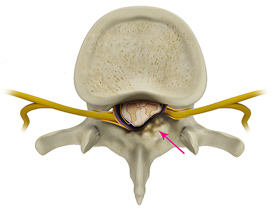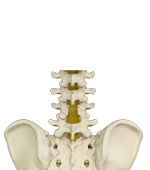Lumbar Laminectomy
A lumbar laminectomy is a spine surgery that involves removing bone to relieve excess pressure on the spinal nerve(s) in the lumbar spine (low back). The term laminectomy is derived from the Latin words lamina (thin plate, sheet or layer), and -ectomy (removal). A laminectomy removes or drills away part of the lamina (roof) of the vertebrae to create space for the nerves leaving the spine.
A lumbar laminectomy can be performed to relieve symptoms such as radiating leg pain (sciatica), or, rarely, back pain.

Why Might I Need This Procedure?
Spinal stenosis is a condition caused by a gradual narrowing of the spinal canal. This narrowing happens as a result of the degeneration of both the facet joints and the intervertebral discs. The facet joints also enlarge as they become arthritic, which contributes to a decrease in the space available for the nerve roots. Bone spurs, called osteophytes also can form and grow into the spinal canal.
These processes narrow the spinal canal and may begin to impinge upon and place pressure on the nerve roots and spinal cord, resulting in such symptoms as
- Back pain
- Pain that radiates into the hips, buttocks and legs
- Numbness, tingling and muscle weakness in the back and/or lower extremities
- Aching pain and heaviness in the legs on walking, termed “neurogenic claudication”.
The goal of a lumbar laminectomy is to relieve pressure on the spinal nerves by removing the part of the lamina and any other tissues which may be the source of the pressure.
Dr. Brazenor will determine if a laminectomy operation (with or without fusion performed at the same time) might help you, after examination of you and your scans. Dr. Brazenor will always explain your non-surgical option (if there is one) as well as the surgical option along with its success rate, failure rate and risks. Except when cancer or dangerous spinal instability is present, it is always Dr. Brazenor's advice that if you are then not sure about having surgery, then you should choose not to have surgery for the moment. Stop, think, and let some time pass, and the correct way for you to manage your condition will become clear.
How Is A Lumbar Laminectomy Performed?
The operation is usually performed with the patient on his or her stomach, sedated under general anaesthesia.


Through an incision made along the midline of the back over the vertebral level(s) to be treated, your surgeon will
- Gently pull aside soft tissue - skin, fat and muscle - to expose the vertebral bone at the back (posterior) of the spine
- Cut away all or part of the lamina to relieve the source of compression
- Remove any other sources of compression; i.e., bone spurs and/or disc material (discectomy)
- Ease the soft tissues back into place and close the incision
A lumbar laminectomy also may be performed in conjunction with spinal fusion. This involves placing bone graft or bone graft substitute between two or more affected vertebrae to promote bone growth between the vertebral bodies. The graft material acts as a binding medium - as the body heals, the vertebral bone and bone graft eventually grow together to join the vertebrae and stabilize the spine.
How Long Will It Take Me To Recover?
Dr. Brazenor will advise you in general terms about your likely postoperative course, but will stress that your final surgical expectations must come from the surgeon or surgeons to whom he refers you. Dr. Brazenor's pledge is that he will only refer you to surgeons whom he knows are capable of expertly doing the operation you need.
You typically will be up and walking in the hospital by the end of the first or second day after the surgery, but your progress thereafter will depend on the magnitude of your operation, whether or not it has cured the underlying pathology, and the effort you are prepared to put into your rehabilitation.
Are There Any Potential Risks Or Complications?
Any surgery and anaesthesia can result in injury or even, rarely, death. One only has to read the newspaper to confirm that fact. Complications such as infection, nerve damage, blood clots, blood loss and bowel and bladder problems, along with complications associated with anaesthesia, are some of the potential risks of spinal surgery. A potential risk inherent in spinal fusion is failure of the vertebral bone and graft to properly fuse, a condition that may require additional surgery.
